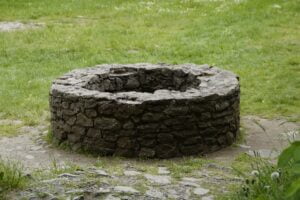Well water or groundwater is the most common source of drinking water. It is obtained by drilling a borehole in the ground and pumping it out of aquifers. Unfortunately, water from such an intake is not crystal clear. It carries dissolved salts, chemicals and microorganisms that can be potentially harmful to the human body. Therefore, it is very important to apply a thorough purification process and select the appropriate water filter.
What’s groundwater?
 Groundwater is largely rainwater that soaks deep into the ground and becomes trapped between rock layers. Depending on how deep the water is, there are two types of wells: deep and shallow. Deep wells are those that require a borehole of less than 20 meters. Shallow wells are those that require a borehole of less than 15 meters. The depth of a well is very important because it lets us know what level of groundwater contamination we are dealing with. In addition, water quality from deep wells can be compromised by high concentrations of naturally occurring hazardous chemicals and minerals.
Groundwater is largely rainwater that soaks deep into the ground and becomes trapped between rock layers. Depending on how deep the water is, there are two types of wells: deep and shallow. Deep wells are those that require a borehole of less than 20 meters. Shallow wells are those that require a borehole of less than 15 meters. The depth of a well is very important because it lets us know what level of groundwater contamination we are dealing with. In addition, water quality from deep wells can be compromised by high concentrations of naturally occurring hazardous chemicals and minerals.
On the other hand, shallow wells usually deal with microbiological and chemical contamination. This is because the water is not protected from surface contaminants by layers of clay and soil. This lack of barrier causes dangerous substances, including human and animal excrement, to seep into the water, causing contamination. Such water obviously cannot be consumed without a proper treatment process.
The level of TDS
(Total Dissolved Solids) of well water is usually higher than that of municipal water supply (which is disinfected before it reaches homes). Usually this rate is around 500 ppm or more. This high level of dissolved substances makes well water generally taste salty, which makes it difficult to swallow. To make it drinkable, advanced purification technologies such as reverse osmosis (RO) and ultraviolet (UV) filtration are needed. In order to choose the right water purification method (RO or UV) we can use the results of TDS measurement.
Which water filter?
If the meter indicates a value higher than 300 ppm (usually a level characteristic of well water), choose a water filter based on RO (Reverse Osmosis) technology. Only this method will remove the excess TDS while softening the water and sweetening its taste. If the TDS is less than 300 ppm, you can choose a water filter based on UV technology only. This is because water with low TDS levels can be treated with ultraviolet rays, which help eliminate any existing bacteria or microorganisms in the water. Nevertheless, most consumers prefer a more advanced system that combines reverse osmosis and ultraviolet technologies. It provides much greater efficiency in removing dissolved substances, especially chemicals and pathogens, making the water completely healthy and fit for daily consumption.
To conclude
water obtained from any source must go through a purification process. Clean drinking water is a must as it helps the body to fight bacteria and viruses. Thus, we shouldn’t compromise on choosing the best water for our home. Otherwise, we take unnecessary health risks.
To find out more about water filters, read other articles in this blog.

